- irrigation management
- rice
- percolation
- scale effects
- hydrologic cycle
1. Introduction
Figure 1). The EGP is characterized by the world’s highest density of rural poor, persistent yield gaps, low agricultural productivity, limited crop diversification, ample water resources [4][5], and highly fertile lands [6][7] of agricultural importance [8]. The region is therefore a global priority for sustainably increasing food production [9].
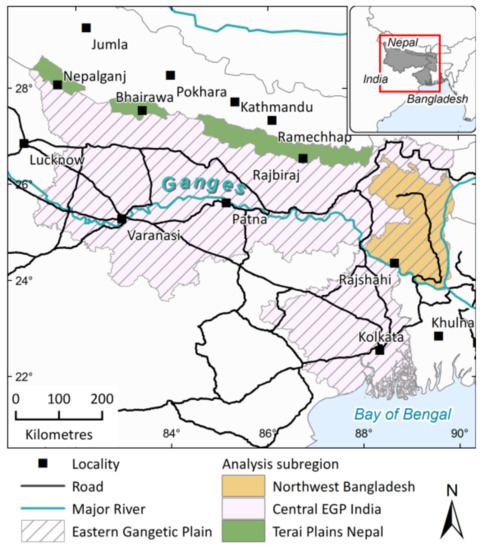
Figure 1.
Agricultural productivity is critically dependent on the availability of water. Adequate water supply significantly increases crop productivity [10][11] by introducing high yielding crop varieties, a better cropping pattern, and increasing cropping intensity [12]. Compared to rain-fed agriculture, irrigated agriculture produces two to four times more crop yields [13]. This contribution of irrigation increased global irrigated land by 76% between 1970 and 2012 [14]; the reliance of agricultural production on irrigation is expected to further increase in the future [15]. Farmers’ capacity to access and use water is a major driving factor in obtaining the best yield and hence is an important variable for the food security index [16]. However, the growing competition for water by various sectors will affect farmers’ ability to produce food [17][18]. So, making food production sustainable, while conserving diminishing water supplies, will be a great challenge in the future [19].
The Ganges basin has a tropical climate, with a distinct wet monsoon (June–September) and a dry winter (November–February); the summer is characteristically hot and humid. Except for the East and North-East hilly regions of the basin where annual rainfall often exceeds 4000 mm, the average annual rainfall in most other parts is 1500 mm. The rainfall is mostly concentrated in the monsoon season and the winter is almost rainless [20] but the main cropping season. In many parts of the IGP, agricultural drought and other climatic shocks severely affect crop production, thus, necessitating an adequate water supply to stabilize agricultural production [21][22]. Surface water is inadequate in the dry season, but groundwater plays a vital role in sustaining agricultural productivity. In India, 60% of the agricultural water requirement is satisfied from groundwater, covering over 50% of the irrigated area [23]; in Bangladesh, the corresponding quantities are 79% and 85% [24]. Of the many factors now threatening sustainability in agricultural productivity, water is the most crucial [25][26][27][28][29][30][31][32][33] since, without further improvement in water productivity, the amount of water needed for crop agriculture is predicted to increase by 70–90% by 2050 [34].
Several resource-conservation technologies like minimum tillage, no/zero-tillage, direct-seeding, bed-planting, laser land-leveling and residue retention [35][36][37], and water-saving technologies like alternate wetting and drying (AWD) and deficit irrigation methods have been developed over the past three decades and are being practiced in many parts of the world, including the EGP. In addition to the benefits from the conserved resources, these technologies can also change crop-water use and the regional water cycle [38] with negative impact on groundwater dynamics [39]. They save water by reducing water application in the fields, with resulting lower percolation and groundwater recharge. Large-scale adoption of these technologies can therefore lead to significant decline in groundwater levels [40][41][42], with possible degradation of soil quality and damage of vegetation [43]. In many parts of the EGP, groundwater level has declined significantly, and is now threatening sustainable water supply for irrigation and drinking [44][45][46][47][48][49] with resulting negative impacts on the economy, society and environment [50][51][52][53]. Although less than one-third of the IGP has experienced declining groundwater levels [54] the situations in high-population centers (e.g., Dhaka city) and other stressed areas (e.g., the Barind area) are potentially alarming [49].
Agriculture in the IGP is mostly dominated by irrigated rice–wheat systems, which cover 13.5 Mha and play a crucial role in the food security and livelihoods of millions of people [37][55][56]. In Bangladesh and West Bengal, rice is produced on 6.05 Mha and 5.5 Mha, respectively [57]. Both mechanized and tillage-based traditional agriculture and transplanted rice cultivation with flood irrigation requiring a huge quantity of water [58][59][60] are a major challenge in agriculture, in order to maintain or increase rice production. Shifting current agriculture to water-efficient ones [61][62][63][64][65] would conserve water from being wasted through unintended purposes and make considerable water savings [66][67][68][69] to face the challenge. Conversion of conventional agriculture to resource-conservation ones [70][71][72] using resource-conservation technologies and water-saving measures has been demonstrated as of particular interest in this regard [29][73][74][75][76].
Figure 2. The local surface and sub-surface hydrological systems retain a considerable portion of the applied water, which might be reusable later by other users. Consequently, irrigation has a direct link to the regional hydrological cycle, especially in areas with shallow groundwater [54]. A large part of the applied irrigation water infiltrates below the root zone and is stored in the underlying aquifer [7][43] or in downstream surface water bodies.
Figure 3)? These important issues have not yet been investigated critically on the system level; only some field-scale studies have investigated the possibilities, which are also contrasting in nature. In light of this short-coming, this paper comprehensively reviewed the available literature to evaluate the present state of knowledge and emerging knowledge-gaps on this subject so as to guide future research on this topic. Note that since rice-based cropping systems dominate the agricultural landscape of the EGP [56], this study focuses on the exchange of water flux between irrigated rice fields and the underlying aquifers. The paper is structured into five major sections in addition to an introduction and a concluding section. The benefits and impacts of conservation agriculture have been reviewed in the second section. The third section highlights the complementary and contemporary meanings of water saving while the fourth section addresses the impacts of agricultural water-saving methods on regional hydrology outcomes (i.e., links between various components of the regional hydrological cycle). The next section identifies current knowledge gaps in the key water-saving issues, including scale-effects and policy, before an overall summary and concluding section on water-saving measures and regional hydrology outcomes.
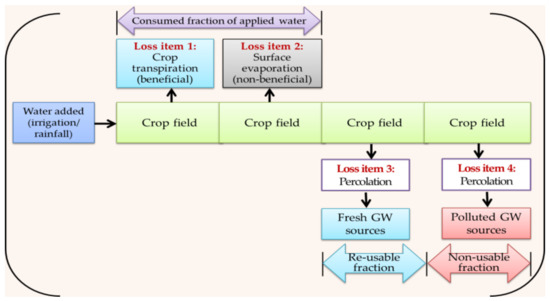
Figure 2.
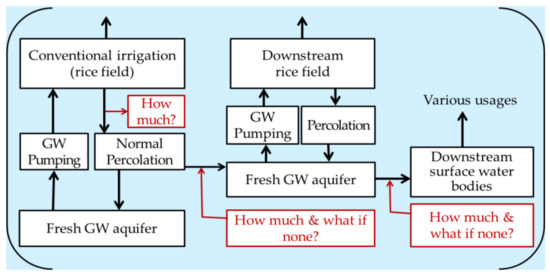
Figure 3.
2. Agricultural Water–Saving
2.1. Water-Saving Measures
Water-saving irrigation, groundwater regulation, shifts to rain-fed agriculture, artificial recharge to groundwater, rainwater preservation, virtual water imports and indirect approaches like energy pricing and regulation are the currently available measures to reduce regional water use [79][80]. However, appropriate water-accounting is essential to identify the scope of these water-saving practices [81]. Based on the approach of reducing evaporation, runoff losses, and the extent of free water on the soil surface [82] irrigation strategies like shallow water depth associated with wetting and drying [83][84], alternate wetting and drying, AWD [85][86][87][88], semi-drying [89], aerobic rice cultivation [90][91], partial root-zone drying [92], and non-flooded mulching [93] are being practiced in different rice-growing regions. The AWD technique allows the soil to dry for a certain pre-determined number of days after depletion of the standing water in the field before the next irrigation [94]. The multiple-shallow irrigation method (1–3 cm irrigation applied frequently) can efficiently utilize rainfall and reduce percolation and surface runoff [95]. In the aerobic cultivation method, rice is grown in well-drained dry soils with supplementary irrigation, as with upland crops [90]. Furrow irrigation with raised beds, mulching, conservation tillage, deficit irrigation [96][97][98] and improved weed control can also achieve substantial water-saving.
2.2. Apparent and Actual Water-Saving
The impact of efficiency of water consumption and water productivity on water-saving has been investigated at field scale on several occasions e.g., [99][100][101][102][103]. Any effort toward improving irrigation efficiency is valuable [104], but the commonly used concepts of water-use efficiency underestimate the system-level’s actual efficiency [78]. The actual fraction of the applied water that is used efficiently at a regional scale has not yet been quantified; current measurement methods are inadequate for such quantification.
Figure 2), and change in storage [105]. These water use-terms allow a clearer definition of various issues and options for water usage in irrigated agriculture. Water-saving through a resource-conservation technology refers to a narrow local perspective of water application by reducing percolation rates, as conceptualized in
Figure 5) or recoverable outflow, where it ends up in rivers or as useable groundwater source [95][105]. The return flow may be a significant contributor to groundwater recharge [106][107][108][109].
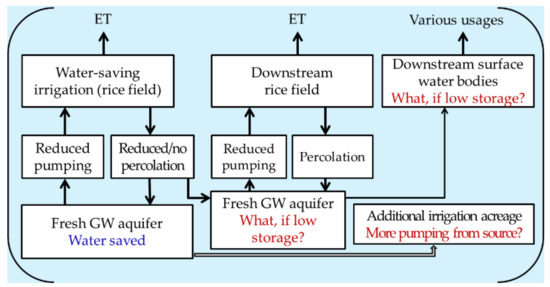
Figure 4.
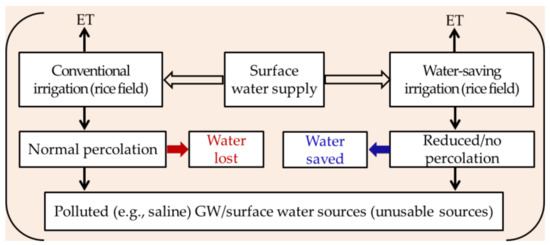
Figure 5.
Due to various natural calamities (e.g., seasonal storms, hailstorms, cyclonic storms, heavy rainfall and floods), dry season is the main and safe cropping season in the EGP, which has an annually renewable groundwater system. Here irrigation is predominantly done with groundwater; 79% of total irrigation in Bangladesh and more than 90% of irrigation in North-West India uses groundwater. An individual farmer considers the combined outflow of water by evapotranspiration, seepage and percolation as water usage by his/her rice field and hence actual water loss in the field. However, when considering a large spatial scale, achieving water-saving by one user may be a loss to another since the seepage and percolation from one’s field enter the underlying aquifer or nearby surface water sources, from where others can reuse the water [75][110] causing no net loss to the system [111][112]. The real water-saving occurs only when the non-recoverable non-usable water losses (
Figure 2) are eliminated or reduced. Avoidance of peak evaporative demand, use of short-duration varieties, cultivating less water-demanding crops, and changing from ponded to non-ponded rice culture are the potential technologies for reducing evapotranspiration [111][112][113]. The practicability and effects of technologies on crop yields must, however, be investigated before their large-scale field adoption.
Modifications of the water balance components by resource-conservation technologies, the fate of water saved through reduced application, and hydrologic interactions across spatial scales determine whether any reduction in water application leads to actual water-saving and reduces water usage [75]. Farmers always intend to achieve maximum output from the water resource, leading them to utilize as much water as they can have access to. Society, on the other hand, prefers utilizing scarce water to maximize profits by shifting water from agriculture to high-value economic sectors. The goals of the two entities in utilizing the scarce water are clearly opposing, and therefore appropriate terminology to describe real water-saving remains a central issue of debate [105].
Interactions between non-agricultural and agricultural water usages are scale-dependent and play a major role in water-saving [114]. At basin scale, the main interest is to reduce water usage in irrigated agriculture and transfer water to other higher-valued usages. This again implies that actual water-saving can be achieved only by reducing evaporation and water-flows to non-recoverable sinks [115]. The basin approach, instead of paying attention to individual water usage, assesses return flows, estimates water-use efficiencies at field- and basin-scales and differentiates consumptive water-saving from non-consumptive saving (
Figure 2) while accounting for water and analyzing water-use efficiencies [116][117][118][119][120]. Despite many complexities in perceptions of water-saving, its ultimate objectives are clear and undisputable: to stop unsustainable exploitation of the available water resources and to increase the quantity of water for other essential and more beneficial usages. It is therefore essential to understand the scale-effects of water usage clearly to improve water-savings and water productivity [86][117][121][122][123].
2.3. Impacts on Water Use
AWD effect: Irrigation management through alternate wetting and drying is widely practiced in many countries/regions like the Philippines, Vietnam, China and EGP [124][125][126][127]. Under AWD, the percolation rate decreases leading to water-saving; the reduction in evapotranspiration plays only a minimal role [128]. Compared to the continuous standing water rice system, the levels of water-saving by the AWD method are listed in
Table 1. Percolation from the crop fields controls the transport of nitrate [95], heavy metals [129], salts [130], nutrients [131], and pesticides [132] to groundwater. So, with reduced percolation the quality of groundwater remains under safeguard. The AWD method also reduces greenhouse gas emission [133][134], uptake of arsenic in rice grain [135][136], the cost of pumping water [137][138], and concentration of methyl mercury in field soil [139].
Table 13.
| Type of Effect | Quantity | References |
|---|---|---|
| Water saving | 23% | [85][108] |
| Water saving | 15–40% | [140][109, [141]110[142][128][143],111,221,233] |
| Water saving | 30–60% | [144][112] |
| Percolation reduction | 50–80% | [144][112] |
| Percolation reduction | 19–28% | [60] |
Bund effect: An unsaturated zone beneath standing water and a higher hydraulic conductivity zone beneath the bunds in rice fields are developed. This causes the applied irrigation water to move through the bunds and recharges the underlying aquifer [145]. The destinations of the applied irrigation water in the rice fields were measured on several occasions e.g., [111][146][147][148][149] and a significant portion was reported to percolate through the field boundaries. This type of lateral seepage flow field is horizontal first and then vertical below the bunds [150]. Often rice fields of irregular shape are transformed into regular rice fields in order to improve irrigation efficiency, keeping part of the previously generated plow pan beneath the bunds of the reformed rice field [145]. Consequently, the dominant movement of water is in the horizontal direction through the bund. The seepage flux is, however, much less than the deep percolation rate [150][151][152] except when rice is cultivated on terraced fields, where the seepage water moves to the downstream plots through the bunds [150]. In flat rice fields, the infiltration rate below the bunds remains close to the average infiltration rate for the crop field with plow pan beneath the bunds, but may double or more without plow pan beneath the bunds [111][150]. [145] demonstrated 50% of water lost through the bunds, 25% through evapotranspiration, and 25% equally through infiltration providing an estimated annual water loss of 41 km
3
Puddling effect: Puddling eliminates large pores and alters the field soils to stratified layers: a top puddled layer, muddy layer and plow pan overlying a lower layer [153][154]. A low-permeable layer, formed above the puddled layer, comprises a finer fraction of the soils in suspension [155][156]. Puddling creates a 5 to 10-cm layer of plow pan, of low hydraulic conductivity, 20–25 cm below the ground surface. The hydraulic properties of plow pan regulate the water regime in the irrigated field [147][148][149][150][151][152][153][154][155][156][157][158]. Water flow occurs under unsaturated conditions below the plow pan [154]. The percolation rate varies widely with soil texture, 3–17 mm/day for clay and 13–30 mm/day for sandy loam [156][159]. The intensity [160] and depth of puddling [161], soil-type and post-puddling time period [162], and ponding water depth [163] regulate reduction of the percolation rate in the puddled soils. The percolation rate is high during the early growth period but decreases by 35–45% with the advance of the growth stage [164][165][166].
Re-bound effect: The re-bound effect, a less-known proposition, suggests that when efficiency of using a resource increases, its consumption rate also increases simultaneously [167]. Jevon’s contradiction/paradox in economics advocates that any technologies aimed at saving energy actually end up by achieving the contrary of what they were supposed to do. Although the re-bound effect is quite well-known in energy usage [168], it is less known in the irrigation literature. Any intervention to modernize irrigation systems will improve efficiency, reliability and flexibility of the system, with a consequent increase in demand and consumption of water, especially by progressive farmers. The re-bound effect is therefore a potential problem in water resource management as recognized by [169].
Figure 1) and hence is not lost or wasted [119]. So, there is a risk of focusing on local efficiency alone and ignoring the return flows [170]. Secondly, based on economic theory [171], water-saving technologies, by adding more value to water, may encourage farmers to use more water as observed by [172] in Pakistan and Yemen where the overall water usage increased significantly [173][174]. Contrasting evidence is also found in the central United States where new technologies reduced water usage [74].
It is crucial to quantify water extracted and water consumed separately in order to effectively investigate the re-bound effect in irrigation. The usage of extracted water can comprise a consumed part and a non-consumed part. The consumed part may comprise both beneficial and non-beneficial evapotranspiration and runoff or percolation loss that are not recoverable. The non-consumed part comprises parts of the runoff and percolation that are recoverable for further use [120][175]. So, efficiency improvements do not always reduce overall water use; these actually reduce the effective cost of net irrigation encouraging the farmers to achieve more benefit by increasing net irrigation [176][177][178][179].
3. Summary and Conclusions
Manifold attempts have been made in different regions of the world to increase food production for the rapidly growing population since the early 1960s. There has been great success in increasing food production globally but with a tremendous resulting pressure on the production-linked resources, specifically water and soil. The accelerating stress on these vital resources in the EGP raises sustainability concerns regarding agricultural production systems. Researchers and practitioners have been facing these challenges, both locally and regionally, over the last few decades. They have developed resource-conservation technologies as a response to concerns about agricultural sustainability, with basic principles of rebuilding the soil, optimizing inputs for crop production, increasing food production, and optimizing profits [180][181][182]. This review study has summarized the benefits of these technologies, and the scale-dependency and uncertainty of some of the benefits. Also identified are the gaps in current knowledge regarding the conceptual aspects of these technologies to make agriculture sustainable over a large regional scale so as to guide the future research in proper directions.
Manifold attempts have been made in different regions of the world to increase food production for the rapidly growing population since the early 1960s. There has been great success in increasing food production globally but with a tremendous resulting pressure on the production-linked resources, specifically water and soil. The accelerating stress on these vital resources in the EGP raises sustainability concerns regarding agricultural production systems. Researchers and practitioners have been facing these challenges, both locally and regionally, over the last few decades. They have developed resource-conservation technologies as a response to concerns about agricultural sustainability, with basic principles of rebuilding the soil, optimizing inputs for crop production, increasing food production, and optimizing profits [84,86,87]. This review study has summarized the benefits of these technologies, and the scale-dependency and uncertainty of some of the benefits. Also identified are the gaps in current knowledge regarding the conceptual aspects of these technologies to make agriculture sustainable over a large regional scale so as to guide the future research in proper directions.Of these resource-conservation technologies, conservation agriculture and water-saving measures are being practiced in many regions of the world, including the EGP [183][182]. Some benefits of these technologies, such as reduced energy and nutrients usage and reduced agrochemical leaching, are scale-invariant and intuitively clear [37][184]. However, the issue of water-saving remains uncertain at the system level since it is both a temporal and spatial scale-dependent element and linked to the regional hydrologic cycle [95][105]. Water saved at the farm level could otherwise join the groundwater or surface water systems to be used later by the same or other users [75][110]. Consequently, whether water-saving achieved at the farm level makes any real saving when considering the entire groundwater or river basin has not yet been adequately investigated. Furthermore, there is evidence of increasing demand for water after adding more value by technological interventions, such as increasing irrigation efficiency by adopting water-saving measures [172]; however, contrasting evidence has also been observed [74]. Whether or not the reduced extraction of groundwater, as well as reduced recharge, under resource-conservation technologies raise groundwater storage/groundwater level or reduce it remains unresolved [185]. Apparently, the reduced extraction of groundwater is expected to increase groundwater storage, but this likelihood is also uncertain since most aquifers in the Gangetic basin discharge to the rivers as base flow in the dry season. Thus, the current level of understanding of the complexity of the hydrological link to field-applied water is inadequate due to lack of measured data on the components of regional water balance. Lack of shared knowledge on the impacts of resource-conservation technologies on regional water balance among the pertinent disciplines, such as agricultural production practitioners (e.g., agronomists, economists, irrigation engineers) and hydrologists (e.g., groundwater hydrologists, surface water hydrologists), is another drawback in planning and implementing holistic approach to investigate regional hydrology outcomes. This inadequate knowledge of inter-linked water systems may lead to the implementation of wrong policy [186][187][188] merely based on local perspectives with eventual worsening of the water-scarcity situation. Therefore, all pertinent disciplines should adopt integrated research approaches to measure the components of local and regional water balance and quantify regional hydrology outcomes over a large temporal scale. Only then proper water management policy can be planned and implemented for sustainable agricultural production.
Of these resource-conservation technologies, conservation agriculture and water-saving measures are being practiced in many regions of the world, including the EGP [85,87]. Some benefits of these technologies, such as reduced energy and nutrients usage and reduced agrochemical leaching, are scale-invariant and intuitively clear [37,83]. However, the issue of water-saving remains uncertain at the system level since it is both a temporal and spatial scale-dependent element and linked to the regional hydrologic cycle [94,95]. Water saved at the farm level could otherwise join the groundwater or surface water systems to be used later by the same or other users [75,103]. Consequently, whether water-saving achieved at the farm level makes any real saving when considering the entire groundwater or river basin has not yet been adequately investigated. Furthermore, there is evidence of increasing demand for water after adding more value by technological interventions, such as increasing irrigation efficiency by adopting water-saving measures [114]; however, contrasting evidence has also been observed [74]. Whether or not the reduced extraction of groundwater, as well as reduced recharge, under resource-conservation technologies raise groundwater storage/groundwater level or reduce it remains unresolved [306]. Apparently, the reduced extraction of groundwater is expected to increase groundwater storage, but this likelihood is also uncertain since most aquifers in the Gangetic basin discharge to the rivers as base flow in the dry season. Thus, the current level of understanding of the complexity of the hydrological link to field-applied water is inadequate due to lack of measured data on the components of regional water balance. Lack of shared knowledge on the impacts of resource-conservation technologies on regional water balance among the pertinent disciplines, such as agricultural production practitioners (e.g., agronomists, economists, irrigation engineers) and hydrologists (e.g., groundwater hydrologists, surface water hydrologists), is another drawback in planning and implementing holistic approach to investigate regional hydrology outcomes. This inadequate knowledge of inter-linked water systems may lead to the implementation of wrong policy [121,122,123] merely based on local perspectives with eventual worsening of the water-scarcity situation. Therefore, all pertinent disciplines should adopt integrated research approaches to measure the components of local and regional water balance and quantify regional hydrology outcomes over a large temporal scale. Only then proper water management policy can be planned and implemented for sustainable agricultural production.